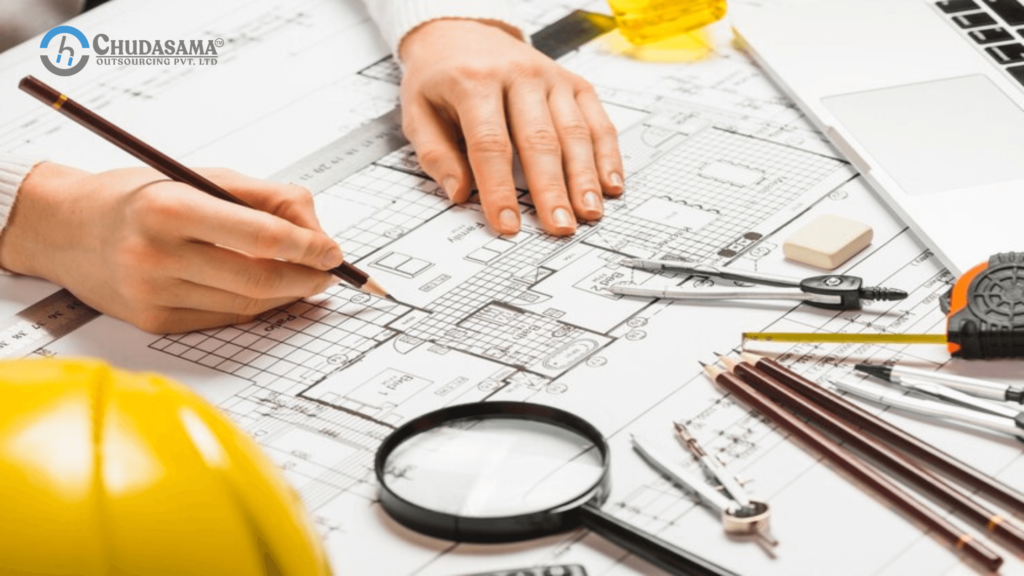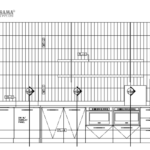Quick summary: Explore the essentials of Schematic Design, Design Development, and Construction Documents in building projects to ensure successful outcomes.
In the construction industry, different stages encompass the initiative in every aspect, from the slip of paper in the inception to the substantial brick-and-mortar. While delegating specific duties to other phases of the project, it is these particular stages, schematic design (SD), design development (DD), and construction documents (CD), that define turning what was on paper into actuality.
In this guide, we go further than that by analyzing the stages in-depth and the aspects that they are concerned with.
Schematic Design (SD)
On the schematic design level, the synergy of project team members with the client is the maintenance of their contribution to establishing the initial concept containing the full scope of the task. This phase is also refer to as “preliminary design” or “conceptual design.
The primary purpose is to sort out a general direction for your project and get the approval of all the stakeholders for further developments. Some critical considerations during this stage include:
By setting a target and direction, understanding the client’s needs and expectations results in clear guidelines to follow.
Going between different options and sketching is my first step. That way, I develop a solution that best suits the problem.
Identification of possible issues and formulation of the problem to solve.
The output of the Sd stage is usually a range of concept drawings, which come as elevations, floor plans, and sometimes even 3D models. These illustrations show us how various design solutions can be presented to the client and how their notes can be used to improve the results.
Key Activities of SD
During this phase, architects will engage in:
- Site Analysis – ensuring eco-friendly impacts on my environment and complying with local building regulations.
- Programming – defining the needs and aspirations of the client.
- Initial design – beginning concept drawings and exploring various designs and space configurations.
- Preliminary Cost Estimating – ensuring the plan is within budgetary parameters.
Creativity and Constraint
Through the efforts of the client and other stakeholders, collaboratively, we maneuver on the tightrope of creative freedom on one side and practical construction facts on the other. Architects explore a lot of different solutions, then only putting into commission the most practical one out of the lot.
Design Development (DD)
The schematic plan is approved, and the project is going into the design development stage. In this project phase, team members try to define and specify design issues that emerge in the SD phase. The accent is on how the final picture will look, with greater detail – materials used, building systems, and structural elements. Some critical considerations during this stage include:
- Finalizing the design concept and making necessary revisions
- Developing detailed drawings and specifications for each aspect of the project
- Collaborating with engineers and other consultants to ensure the feasibility of the design
Here, one only gets an overall project draft, but after using DD, a person gets a highly detailed set of plans in layouts, elevations, sections, and work specifications. This permission to start the construction process is issued to people to estimate the possible construction material and service costs and start the construction process.
What are (CD) Construction Documents?
The climax of the construction preparation is the construction design phase, which is the production and approval of the Construction Documents.
These will serve as the fundamental models and specifications with which any screw will be driven and every stone placed. They are a package of instructions that guide and present every aspect enough to build the structure without oversight and evening errors.
The Technical Blueprint
Construction drawings need to be as thorough as possible. Still, they also have to be accurate enough to allow for unforeseen changes that may take place at the site, yet not complicated enough to leave unwilling changes.
Key Elements of Construction Documents
These elements typically include:
- Architectural Drawings – floor plans, elevations, sections, and details.
- Structural Engineering – including beams, columns, and foundation details.
- Mechanical, Electrical, and Plumbing (MEP) Drawings – indicating the positioning of HVAC, lighting, and plumbing systems.
- Specifications – a detailed outline of materials, finishes, and the quality of work to include in the project.
The Rise of an Identical Language
The construction documents are mainly mean to facilitate accurate and clear communication. Such visuals are represent by typical industry diagrams, drawings, and dimensions. This universal language naturally forms a backbone that connects all the project team members into one single-minded approach, which is to achieve the final structure harmoniously and in no parallel way.
The Differences Between SD, DD, and CD
Knowing the specific role(s) and outputs (endif) of Schematic design, Design Development and Construction documents in a project is essential. Though all three phases have their exclusive roles to play, it is crucial to see the distinct characteristics of them.
Schematic Design vs. Design Development
At the stage of Schematic Design, we need to talk in big-picture terms. The schematic designs make the grand concepts concrete by gradually putting together detailed specifications, systems, and related context.
Design Development vs. Construction Documents
Design Development is when the designers all cooperate and settle on what the final product will look like. Construction documents are about technical details, and the contract between the architect and builder is almost like a legal issue, ensuring the facade is execute correctly.
Transitioning from Design to Implementation
This sequence starts from more general ideas and then progresses slowly to more specific ones. On the one hand, this is a collaborative effort aimed toward nailing down the details, concluding all the talk, and the start of documentation that evolves the design into a practical and well-thought-out project.
The Importance of SD, DD, and CD in the Construction World
The persons not working closely with construction projects on a day-to-day basis may undervalue the SD, DD, and CD phases, resulting in poor decisions being make during these phases. Nevertheless, the concrete activity of high-level job positions is significant, and they serve as the pillar for the success of the project execution.
HVAC systems are systematically arrange for the most cost-effective and time-saving projects, which will eventually deliver a finished product that pleases the clients and is structurally sound.
Cost Control and Client Satisfaction
The design cost is kept within a healthy range and visible throughout the Schematic Design as well as Design Development, informing the clients along the way. CAD and BIM, being among the most used software, help in the development and approval of the design. However, the Construction Documents phase sets in when the vetting is customer expectations are about to close.
The Binder That Holds the Project Together
The construction documents are indeed not just the final step but the actual thread that holds the similar mission of the architects and the builders together. They serve as a guide to the exact locations and the objective approach for completing the job in a timely and organized manner.
The Benefits of Outsourcing Schematic Design, Design Development, and Construction Documentation in Architecture
Outsourcing architectural services, including Schematic Design (SD), Design Development (DD), and Construction Documentation (CD), is shown to be quite advantageous for a firm. Through this approach, not only are project workflows being streamlined, but also efficiency is improve; a win-win situation is crafted by both parties involved.
In this way, architectural companies use experts to provide their outsourcing, focusing on their core competencies and ensuring great design and documentation that satisfies market needs.
The Benefits of Specialization
Architectural firms that specialize in the preparation of SD, DD, and CD drawings can develop comprehensive, context-specific designs with proficiency and speed that are hard to duplicate when you design in-house.
Leveraging Technology
Outsourcing, at times, also means that you can get the newest software, design knowledge, and the local regulations that are in force. This, among other things, is good for the project but also for the prestige of the architect.
Conclusion
Finally, scheme design, draft design, and construction documents are the primary stages in the project, and Chudasama Outsourcing specializes in architectural construction documentation services.
This procedure possesses its own specific charters at each step, thus essential for the transition of a concept into a real object. Knowing and applying best practices at every stage, we are going to ensure that our projects are complete successfully.
All the aspects of the industry chain that take part in the construction will need to realize these stages and work together as a team efficiently. Now, if you are indeed looking toward starting or presently in a construction project, then it is require that you be affecting Chudasama Outsourcing’s expert services and that you keep this guide handy.



